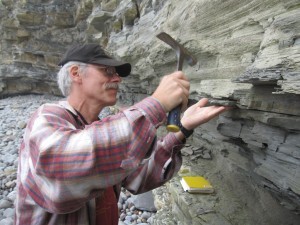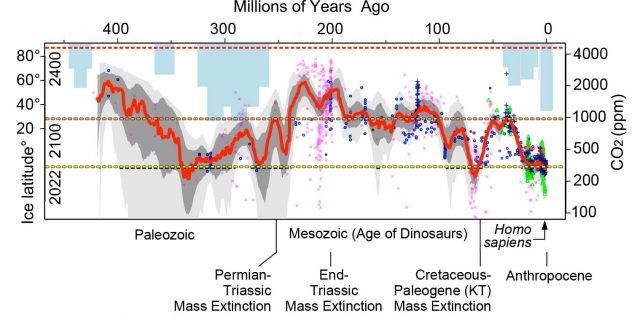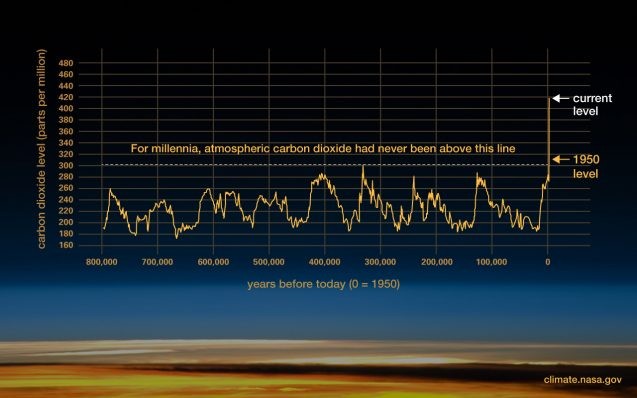You Asked: Dinosaurs Survived When CO2 Was Extremely High. Why Can’t Humans?
Our expert says: Although carbon dioxide levels have been much higher in the past, they generally increased slowly, giving plants and animals time to adapt. When the rate of climate change was staggeringly fast, like today, there were big problems.
“You Asked” is a series where Earth Institute experts tackle reader questions on science and sustainability. A reader reached out to us with this question: “How did plants and animals survive around 200 million years ago when the carbon dioxide concentration went up to 6,000 parts per million?” Paul Olsen, a geologist and paleontologist at Columbia Climate School’s Lamont-Doherty Earth Observatory, walked us through what scientists know about carbon dioxide levels over time.

Although no one was around to measure the atmosphere’s CO2 concentration millions of years ago, paleoclimatologists can reconstruct past temperature and carbon dioxide levels using ice cores, tree rings, corals, ancient pollen, and sedimentary rocks. These natural recorders of climate fluctuations can also reveal how various animals and plants thrived or perished during different geological periods.
While studying the Age of Dinosaurs, for example, some researchers dissect leaves that got trapped in sediment layers. “The little holes in the skin of leaves are more common when there are lower carbon dioxide levels,” explained Olsen.
Scientists like Olsen have repeatedly found that during several periods of Earth’s history, organisms have experienced radically higher concentrations of carbon dioxide and hotter average temperatures than today. However, that doesn’t mean everything will be fine if we keep heating the planet by burning fossil fuels.
“The problem today is not higher global temperature or carbon dioxide levels alone. The problem is the rate of change,” explained Olsen. “Throughout most of the Earth’s history, carbon dioxide levels have generally changed very slowly. That gave organisms and their ecosystems sufficient time to adapt to climate change through both evolution and migration.”
Climate scientists warn that over the next century, the rate of change will be 10 times faster than any climate pattern that unfolded in the last 65 million years. Because of today’s rapid rate of warming, up to 14 percent of all plants and animals on land may face extinction in the coming decades, according to a report from the Intergovernmental Panel on Climate Change.
Earth’s climatic ups and downs
During the Cambrian Period, which lasted from 542 million to 485.4 million years ago, some sources estimate that CO2 levels may have been about 20 times higher than today, and temperatures were hotter by 10 degrees Celsius.
Living things didn’t seem to mind the scorching conditions. During this time, the oxygenation of the oceans led to a burst of life known as the “Cambrian explosion.” There was a diverse range of marine creatures like trilobites, including larger ancient predators called Anomalocaris, and slug-shaped animals with shells. Meanwhile, on land, the earliest plants started taking root around 500 million years ago, possibly enjoying high levels of atmospheric carbon dioxide, said Olsen.
“But the proxies from 500 to 400 million years ago are not that well worked out at this time,” he cautioned. “Most of the data and graphs of carbon dioxide levels in the Earth’s history start at around 350 million years ago.”

During the Ordovician Period (around 488.3 to 443.8 million years ago), the sea level was as much as 220 meters higher than today; the regions north of the tropical belt were under the ocean. Primitive fish, red algae, corals, and a few other marine animals like cephalopods and gastropods were a part of thriving ecosystems — until they were struck by an unprecedented tragedy, which may have been triggered by sudden changes in CO2 levels.
It was Earth’s first major mass extinction. Beginning about 443 million years ago, it wiped out approximately 85 percent of all marine species for up to two million years. The cause remains unknown, but some scientists speculate that it might have been associated with the formation of massive glaciers and a drastic drop in sea levels after the super-continent Gondwana drifted towards the South Pole. A 2012 study suggested that the first land plants might have caused global temperatures to plummet by absorbing CO2, triggering an ice age. Conversely, in a 2020 study, Canada-based scientists hypothesized that widespread volcanic eruptions released huge amounts of carbon dioxide that abruptly heated the planet and set off two pulses of mass extinctions within two million years.
How did dinosaurs survive despite exceptionally high CO2 levels?
The Triassic Period (252 to 201 million years ago) kicked off the age of dinosaurs.
“Back then, it was extremely hot because concentrations of atmospheric carbon dioxide were five times higher than today’s levels,” explained Olsen. “And yet, marine and terrestrial life was thriving.”
At the beginning of the Triassic Period, the supercontinent of Pangea encompassed the landmass of all seven modern-day continents. Mammal-like reptiles or synapsids dominated the world. Frogs and salamanders were just beginning to evolve. Following this, a wider range of archosaurs — a group of reptiles that includes crocodilians, birds, and dinosaurs — took over.
The first dinosaurs appeared around 232 million years ago. They were as small as dogs.
For the Late Triassic and earlier Jurassic (approximately 237-174 million years ago), scientists found zero evidence of polar glacial ice sheets in fossil records — likely a result of carbon dioxide levels that may have reached as high as 6,000 parts per million. During this greenhouse state, dense conifer and deciduous forests covered most of Pangea from the North Pole and the South Pole to the subtropical latitudes.
However, around 230 million years ago, Pangea started breaking up. While North America drifted away from Eurasia and Africa, magma intruded into Earth’s crust over a huge area, causing one of the most significant volcanic eruptions in the Earth’s history. It triggered a mass extinction event 202 million years ago that eliminated 80 percent of all organisms, including many formerly dominant types of large tropical reptiles of the Triassic, such as the crocodile-like phytosaurs.
Most researchers believe that the end-Triassic mass extinction event is directly connected with the widespread volcanic eruptions, said Olsen. Each eruption might have lasted continuously for tens or even hundreds of years, and there were many eruptions. They were associated with an abrupt doubling to tripling of atmospheric carbon dioxide within a short time.
“It is quite comparable to what humans are doing to the planet now,” he said. A 2019 study revealed that human activities are annually unleashing up to 100 times more carbon in the atmosphere than volcanoes.
The unusually high carbon dioxide levels 202 million years ago resulted in ocean acidification and anoxia, or loss of oxygen underwater. Olsen and his colleagues identified these factors as the biggest drivers of this great mass extinction event that wiped out marine invertebrates and corals.
In a recent study, they found that huge amounts of sulfur dioxide were also pumped into the atmosphere during the various pulses of volcanic eruptions. That caused intense, albeit short, cold periods as the sulfur aerosols reflected sunlight into outer space.
“That cold period might have lasted for only a few years or 100 years at most,” Olsen explained. On land, volcanic winters eliminated animals that did not have insulation such as feathers, fat, or thick layers of fur. Dinosaurs that had sufficient insulation survived and took over.
After each brief cold period, the Earth experienced tens to hundreds of thousands of years of global heating due to the abrupt increases in atmospheric carbon dioxide levels from the eruptions.
How did global temperatures and CO2 levels stabilize before people came along?
Extremely high concentrations of carbon dioxide disappear from the atmosphere through three major mechanisms. The first one is that the ocean absorbs large amounts of it to create an equilibrium in the atmosphere.
Earth’s second mechanism to suck CO2 out of the air is through the weathering of rocks. The products of this type of natural carbon sequestration end up in the oceans as limestone.
The third mechanism is photosynthesis. Plants absorb carbon dioxide, and if they get buried in sediments before they decompose, the carbon in their tissues gets stored underground. These three mechanisms occur slowly over several thousands of years.
“But when the Earth experiences rapid changes in the concentrations of atmospheric CO2 — like what we are experiencing today because of human activities — these three mechanisms do not respond fast enough to compensate for the staggering rates of change,” explained Olsen.
Over the last 60 years, the annual rate of increase in atmospheric CO2 has been 100 times faster than the relatively recent natural increases that took place around 17,000 years ago at the end of the last ice age. In 2021, the global average concentration of CO2 hit its highest recorded level of 414.72 ppm.
“This is similar to the rate of change that occurred around 202 million years ago, after gigantic volcanic eruptions and also, after asteroid impacts that triggered the fifth mass extinction event around 66 million years ago,” Olsen added.
Could humans survive hostile climatic conditions like those of the Dinosaur Age?

Although the Earth has seen countless fluctuations in carbon dioxide levels in the past, most of them have been at rates at which organisms have been able to adapt and evolve to climate change. This is less likely at today’s rapid pace of warming.
“The rate of change that we are experiencing today because of human-driven greenhouse gas emissions is among the very highest that the Earth has ever seen,” said Olsen. “Higher levels of carbon dioxide in the atmosphere are normal states for our planet. Our current lower state is unusual. Yet, it is this rate of change that is the most important.”
Olsen hypothesized that even with extremely high atmospheric CO2 levels of 6,000 ppm that were recorded during the Age of Dinosaurs and the subsequent global heating, humans could potentially survive — thanks to technological advancements, rather than evolution.
And even though the interior regions of continents would be unbearably hot, places at higher latitudes may still be cool and inhabitable.
However, with high rates of climate change over short periods, Olsen warned that there will be significant social disruptions due to limited food and water resources — resulting in wars and conflicts.
In other words, our species could theoretically survive, but we probably would not be living our best lives.
